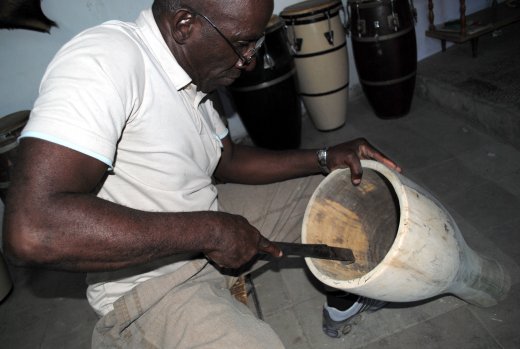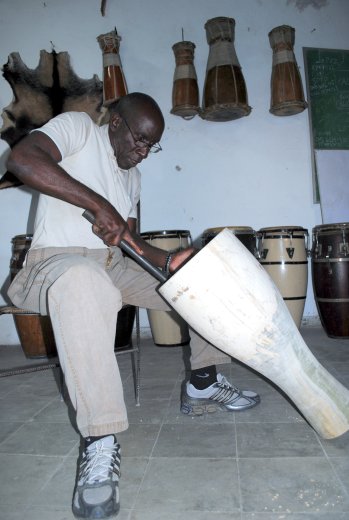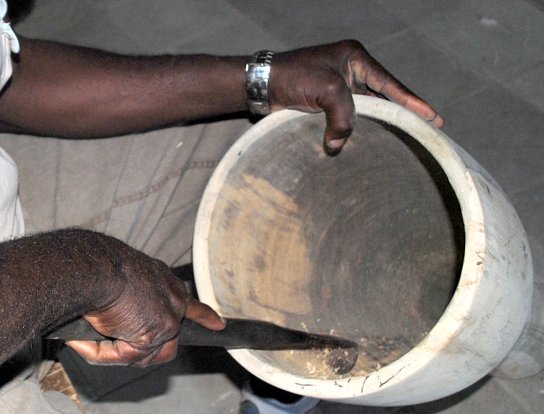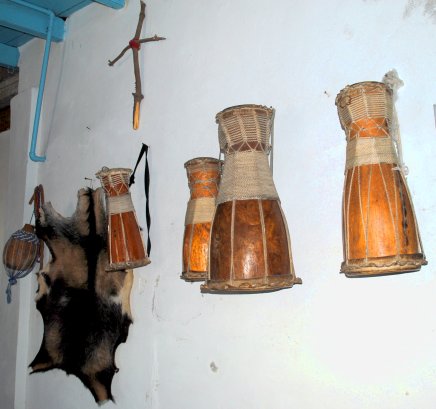Chatting with a Maker of Sacred Drums
Erasmo Calzadilla

HAVANA TIMES, Nov. 21 — My interest in drum percussion moved me rapidly from the bongo to the batá. Actually the batá is a set of three Afro-Cuban drums on which is played in intense, suggestive and beautiful ceremonial music that has me caught and won’t let go. Looking for drums of this type and an instructor who could teach me, I was referred to Juan Bencomo Pedroso, who lives on Vives Avenue in Old Havana.
After helping me to select and acquire an instrument, Bencomo kindly granted me an interview for Havana Times.
HT: Your house looks more like a workshop-study than a home. Have you been involved in music for a long time?
Juan Bencomo Pedroso: I began in elementary school. In my time, music was a subject that was more integrated into the curriculum. But Afro-Cuban music came a little bit later for me; I must have been about eleven. The neighborhood where I lived was influenced by different orishas [Afro-Cuban spirits or deities], so that’s how I was introduced to the panorama of Afro-Cuban religious music.
HT: Are you referring to a neighborhood here in Havana?
JBP: Yes, Cayo Hueso [a part of Centro Havana]. There was a strong tradition of religious music back then.
HT: So you mean that your training was not academic?
JBP: It was academic later on, but not that which related to African music. Religious music wasn’t dealt with in academia.
HT: When did you decide to start making musical instruments and what led you to this?
JBP: I began in 1961. I attended so many ceremonies that I started to get interested… The elders wouldn’t allow you to play the sacred instruments, so you had to learn to play adlib, by observing and copying, things like that. I began in a self-taught manner and they would later correct what I was doing.

This was how I got into the field of making Afro-Cuban instruments: the batá, arará, congo, abakuá and other types of drums – I created all types.
HT: In other words, you didn’t use sophisticated tools like lathes and so on?
JBP: No, no, it was totally by hand, or with the use of an axe, a machete, a brush or a hammer. This is how the tradition is preserved. Now, though, instruments are made industrially, but those don’t serve for liturgies. In terms of Afro-Cuban drums, the practice of handcraftsmanship is being extinguished… I don’t believe very many people are still engaged in this.
HT: Why do you believe that this practice is fading away?
JBP: Because religious craftsmen don’t share their knowledge widely; they hoard it. I’ve given myself the task of teaching this discipline of how to build, play and dress drums, and how to sing and pray with them, which is part of the tradition.
HT: Do you have good apprentices?
JBP: My son Juan, the oldest of my boys. Up to now he’s been developing fine. He has a lot of discipline…
HT: So we can trust that your knowledge is in good hands, that it won’t be lost?
JBP: Of course not, and we’re also teaching a group of children from the community. We’re familiarizing them with these endeavors. Apart from building instruments, I’m also the neighborhood’s cultural promoter and I give workshops. Shortly one will be offered on musical handicrafts where we will teach people how to dress and tune drums.
HT: To “dress” a drum means fitting the leather drum skin over the shell?
JBP: Right, to fit the leather using tightening cords, and then we teach them the process of tuning.
HT: Is this the only thing the children will be taught?
JBP: No, we teach them dance, percussion, songs, painting and a little literature – everything that’s related to Afro-Cuban culture.
HT: When you say children, are you referring to both females and males?

JBP: Yeah, sure, lots of girls come too.
HT: Does the neighborhood community center offer any support for these workshops?
JBP: No, the cultural center here has done absolutely nothing. Our teachers are independent artists, members of UNEAC [the National Union of Cuban Writers and Artists], and we finance the cultural initiative out of our own pockets. This isn’t easy because the children break a lot of the instruments in the process of learning.
HJ: So what’s the initiative called?
JBP: It’s named after my father. It’s called the Faustino Cipriano Bencomo Varona Initiative: The Rescue of a Tradition.
HT: Did your father play or build drums?
JBP: No, but he was a self-taught musician and he used to play in a sextet.
HT: I know that of those African instruments that evolved in Cuba, the batá is very well known. I also understand that marked differences exist between the secular batá and the religious batá. Could you tell us something about this?
JBP: They differ in their construction. The secular batá is made with pegs similar to the conga drum, while the religious batá uses only wood and leather.

But the most important thing is that the religious batá demands a ceremonial discipline with rites to fill the drum with an entity called the añá; it’s also necessary to feed them. These are matters that are little talked about; the osainistas, not me, are those ones who make this part of the drum.
HT: I’ve heard that people who have had sex the day before the ceremony can’t play the drums with conviction.
JBP: The day before, no. The preparation has to begin at least 72 hours prior.
HT: Are women able to play these drums?
JPB: Women can play the batá, but not the ceremonial one. The festive one is fine, but the ceremonial batá is not a discipline for women.
HT: Is there any explanation for this? Is it like this because tradition says it should be?
JBP: It’s a Yoruba tradition.
HT: You’ve spoken to me about your trips abroad. You’ve gone on these as a musician?

JBP: No, as a craftsman. I’ve been to Spain, France, Slovenia and Germany.
HT: Is there interest in this outside our country?
JPB: Absolutely, people are hooked on it. In places the least imaginable people want to learn about Afro-Cuban tradition. I have a work on display at the ethnographic museum of Slovenia.
I took it there in 2005 when I went to receive an award that was bestowed on me by that country’s television network.
HT: Let’s hope that you can continue working and receiving awards because of that. What you’re doing is noble and important, and I think you deserve them. We won’t rob you of any more of your time. Thank you for the drum and the interview. If someone reads this and wants to get in contact with you, how can they do that?
JBP: In that case they can send me an e-mail at [email protected]; or they can call my representative in Havana at 861-5970 and 867-7947.






Most of the older African Cubanos who have this skil learned from my father in his yrs in Matanzas..I will pass this on to him in California..( or the skill was passed down. as it was to dad).My father for those who do not know is Felipe Garcia Villamil google him
Great piece thank u
All Rumberos eg Congueros will appreciate this.
Gracias